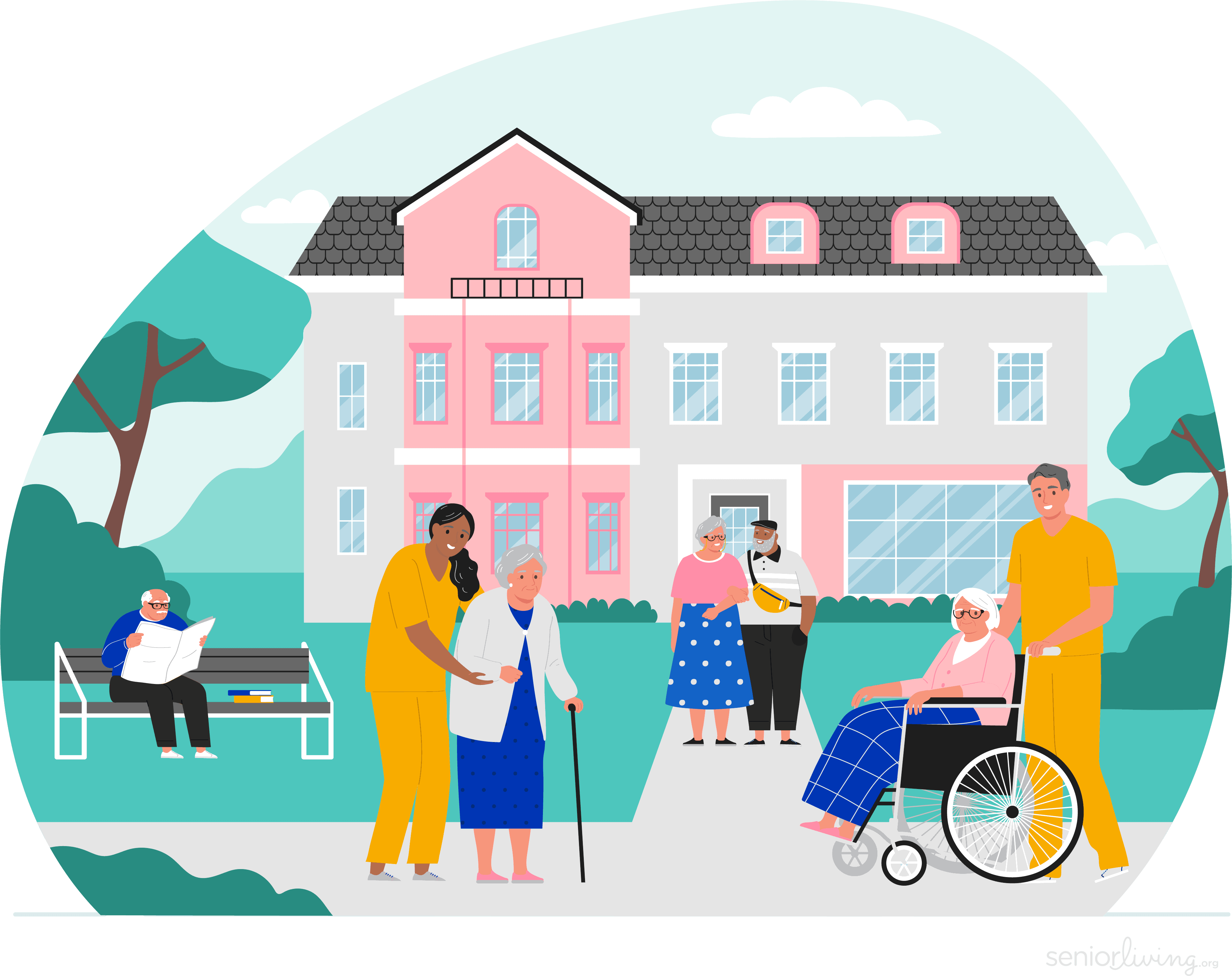Assisted Living vs. Memory Care
Assisted living is designed for those who need assistance with daily tasks, but are still relatively independent. Memory care is for those experiencing memory loss who need 24/7 monitoring and assistance.
SeniorLiving.org is supported by commissions from providers listed on our site. Read our Editorial Guidelines
Find Assisted Living or Memory Care Near You
Join 1,019,247 Seniors Who've Searched for Housing Communities on SeniorLiving.org.
Or Call: (855) 241-1699Find Assisted Living or Memory Care Near You
You’ve probably seen ads targeting older adults featuring vibrant and friendly senior living communities. The communities have come a long way, and now focus on more individualized and compassionate care in a stimulating environment. Many senior living communities include resort-style amenities that allow older adults to socialize while they partake in swim classes, game nights, nature walks, and more.
Making the decision for long-term care for yourself or a loved one can be difficult, but understanding the types of long-term care can help make the decision a little easier. Two common options are assisted living and memory care. Both provide supportive care from trained staff for individuals with different types of independence levels and cognitive issues. Before shopping around or touring either, it is important to know the benefits of each to find the right fit.

Table of Contents
Our free housing and care finder uses your unique needs to curate a list of the best options in your area.
What Is Assisted Living?
Assisted living is for individuals who require assistance with instrumental activities of daily living (IADLs) but enjoy an independent lifestyle. Although considered a form of long-term care (LTC), it falls on the more independent end of the LTC spectrum. Residents of assisted living facilities typically live in their own rooms but interact with others in common areas for social and recreational activities. The number of residents at an assisted living facility can be as few as a dozen or more than a hundred. Residents typically have regular prepared meals and snacks, housekeeping, and laundry service. Staff members help with personal care, medications, and other services that may be customized for each resident.
Assisted living communities may also provide personalized support to individuals who need help with activities of daily living (ADLs) such as bathing, dressing, and toileting. Trained staff offer assistance while encouraging residents to maintain as much independence as possible. More than 30,000 assisted living communities operate across the U.S. caring for some 1 million residents, according to the National Center for Assisted Living (NCAL).1

What is Memory Care?
Specialized and enhanced care for adults with Alzheimer’s disease and other types of dementia is called memory care. When it becomes difficult to care for at home an adult with cognitive impairment, it may be time to consider memory care. It provides support and activities for adults to help them maintain their quality of life. Memory care communities have around-the-clock, specially trained staff that provide safe, secure, and structured environments. Staff members are experienced in handling behaviors such as aggression and wandering, and they offer activities that help with cognitive function and stimulate residents at different disease stages.

Assisted Living and Memory Care Similarities and Differences
Both types of long-term care have unique benefits. Below are some things they have in common and some ways in which they differ.
Security: Both have secure and safe communities. Memory care communities also often have signs and pictures to help orient residents, alarms on doors, motion-sensor lighting and sinks, and cameras to monitor activity as a safety precaution.
Training: Both employ nurses and certified nursing assistants. Staff members at memory care communities have specialized training and certification to work with adults with dementia, including Alzheimer’s disease.
Dining: Both provide three meals a day, plus snacks. Both may provide special diets and additional support with dining.
Activities: Assisted living communities place a big emphasis on entertaining guests and keeping them engaged. They may provide music areas, crafts and games rooms, swimming pools, fitness and wellness centers, hair salons, gardens, and outdoor excursions. Memory care communities also feature many of those activities, but with a personalized service plan and a focus on supporting cognitive function, such as through music therapy.
Transportation: Both provide transportation services and have vans or buses to transport residents to medical appointments, errands, and social outings.
We’ll take a side-by-side look at the two types of care below.
At a Glance: Assisted Living vs. Memory Care
| Similarities and differences | Assisted living | Memory care |
|---|---|---|
| Availability of government assistance | Nonexistent to limited | Largely available, but with potential downsides such as limited selection of facilities and wait times |
| Focus on supporting cognitive health | Yes, assisted living facilities are focused on supporting independent living, socialization, and recreational opportunities in ways to buffer and strengthen cognitive health. | Although dementia is associated with cognitive decline, memory care communities have trained staff who work with residents to keep up with socialization and other activities supporting cognitive health. |
| Degree of independence | Excellent | Limited and monitored (due to safety and impaired ADLS) |
| Skilled nursing available | Yes, but it depends on the facility | Yes |
| Pets allowed | Generally yes, but may vary based on the facility | Not typically. Some memory care facilities may use animal-based therapy, such as dog visits |
FYI: Most assisted living facilities are pet-friendly. A pet assessment may be required to check if the resident can care for the pet alone and to ensure the pet won’t hurt other residents.

SeniorLiving.org is supported by commissions from providers listed on our site. Read our Editorial Guidelines
Signs It May Be Time for Assisted Living
Asking for help may not be easy, but extra assistance can be beneficial to carrying out daily life while maintaining cherished independence. No matter what stage in life you or your loved one is at, an assisted living community can meet your needs. Below are some signs assisted living may be a good option.
- Driving abilities change: Vision, hearing, and reaction time can decline as you age. Many seniors drive into their 90s without any issue, but loved ones exhibiting road rage or getting in frequent fender benders may be ready for assisted living.
- Difficulty with upkeep of household or yard: Vacuuming, laundry, taking out the trash, dusting, bathroom cleaning, and yard upkeep can get difficult as you age. Completing strenuous daily chores can be too much for — and potentially injure — aging adults.
- Chronic health problems: Seniors suffering from cancer, heart disease, or another condition may get worse as they age and require the 24/7 care of a long-term facility that can adequately address their medical needs.
- Lack of mobility: Difficulty going up and down stairs or getting around can leave an older adult unsafe and frustrated. It can also lead to falls without the ability to call for help.
- Isolation and depression: A lack of transportation and social life can leave older adults feeling isolated and depressed. Assisted living can provide an abundance of activities to participate in and opportunities to socialize.
- Difficulty with preparing meals: Cooking may not be as quick or easy as it used to be, and it may lead to more takeout orders and frozen meals. Assisted living communities provide healthy meals three times a day.
Signs It May Be Time for Memory Care
When caregiving for a loved one starts to take a physical or mental toll on family members, it may be time to consider memory care. Memory care generally requires a diagnosis of dementia. There are certain behaviors that can indicate that a loved one may have signs of dementia and benefit from living in full-time memory care. If a few of these are true of your loved one, consider connecting with their medical provider if you haven’t already.
- Lapses in memory: It’s normal to become forgetful as you age, but more frequent memory lapses, combined with confusion, mood changes, and repetitive questions, can be a sign of dementia.
- Loss of direction or sense of time: Momentarily forgetting what day it is, where you are, or how you got there can be early signs of memory loss and/or dementia.
- Increased risk of bodily injury: Examples include forgetting to turn off the stove burner and faucets or wandering outside the home.
- Forgetting to pay the bills: Forgetting to pay the bills happens, but it becomes a cause for concern when suddenly internet service doesn’t work or the electricity is shut off due to overdue bills.
- Isolating and withdrawing: Older adults who prefer to stay home and don’t enjoy the things they used to enjoy can be another sign of developing dementia.
- Not taking care of their health: That includes forgetting to eat or drink, skipping or accidentally doubling up on medication, and failing to follow up with doctor visits and other health-related appointments.
- Neglecting personal hygiene: Older adults who would benefit from memory care may forget to bathe, not know how to bathe, or forget to brush their teeth or dress themselves.
- Increasing agitation: Older adults who start becoming violent or exhibiting abusive or aggressive behavior may need memory care.

How to Know Which Long-Term Care Is the Right Fit
Choosing long-term care for yourself or a loved one naturally takes time and consideration. It’s important to choose the right kind of care to meet your needs and expectations.
Assisted living: Assisted living may be the right fit for someone who needs help with IADLs such as cooking, medication management, and housekeeping without intensive medical or nursing care.
Memory care: Memory care may be the right fit for someone with worsening memory issues who is becoming more difficult for family members to properly care for in many aspects of their daily life. Generally, they need help with most ADLs, which refer to the basic tasks essential for self-care and daily functioning, including eating, dressing, bathing, toileting, and mobility.
Seniors who do not have significant memory loss can do well in assisted living, while those who are experiencing notable memory loss (specifically dementia) may find a better fit in memory care, since memory loss is progressive. Knowing which one to choose is important, as is determining if you want a long-term facility that provides a continuum of care. “Continuum of care” refers to facilities that offer different levels of care as residents’ needs change. Not all senior communities provide a continuum of care, but it’s a good idea to plan ahead if you’re considering that option.
Assisted Living Communities That Include Memory Care
Memory care is sometimes offered in a separate wing within assisted living. The benefit of that type of community is that it offers residents a continuum of care. For example, if a resident enters assisted living with early signs of dementia or develops cognitive impairments later, they can receive care in the same community they are already a part of. Transitioning from assisted living to memory care can be smoother with familiar staff, surroundings, and faces. It can also be easier on families, since they won’t need to look for new care for their loved one.

The biggest potential disadvantage to assisted living communities that have a memory care wing is that it may have fewer resources and specially trained staff devoted to care for residents with dementia. The focus may be more on keeping residents safe and preventing them from wandering off, rather than working on supporting cognitive decline. Every facility is different though. A memory care wing within an assisted living community may be advanced and far better than a stand-alone memory care community. It’s important to do your research and tour communities to find the best fit.

What to Consider When Selecting a Senior Community
Once you have determined which type of long-term care is most suitable, there are some things to consider when choosing the right one.
- Determine your needs or the needs of your loved one and family.
- Research locations, facility size, safety, cleanliness, and staffing, including the ratio of caregivers to patients.
- Contact and tour different facilities.
- Ask questions about amenities, medical care, dyadic support (if relevant), continuing care, and other services.
- Find out about costs.
Assisted Living and Memory Care Costs
Assisted living costs and memory care costs can have a wide range depending on where you live, since states differ in the way they administer long-term facilities. Other factors that impact cost include the level of care you choose and the type of community or facility.
Assisted living has a median cost of $6,259 per month in 2025, based on Genworth estimates.2 Memory care costs $6,160 a month, according to 2023 figures from Dementia Care Central.3 Total costs can vary based on the state you reside in. Costs can, for example, range from $6,600 to $8,250 in the Northeast and West Coast.
Did You Know? Long-term care services at a memory care facility may be tax deductible, depending on the progression of a resident’s dementia, according to NCOA.4
Costs are typically paid using insurance benefits (for medical or health services), personal savings, and assets. Medicare and Medicaid don’t cover assisted living room and board, but they may assist with health care received at the facility.5 Memory care is typically covered with a combination of long-term care insurance, personal savings, veterans benefits, and Medicaid.
-
AHCA NCAL. (2024). Just The Facts: Assisted Living Is A Safe, High-Quality Long Term Care Option For America’s Seniors.
-
Genworth. (2025). Cost of Care Survey.
-
Dementia Care Central. (2023). Alzheimer’s / Dementia Care Costs: Home Care, Adult Day Care, Assisted Living & Nursing Homes.
-
NCOA. (2023). The Cost of Memory Care: What To Expect.
-
NCOA. (2023). How Much Does Assisted Living Cost?



